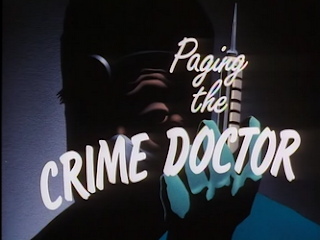 “I brought you some more equipment, the latest in medical
technology. After all, nothing’s too good for my brother, the crime doctor.”
“I brought you some more equipment, the latest in medical
technology. After all, nothing’s too good for my brother, the crime doctor.”Crime lord Rupert Thorne (John Vernon) has taken ill and needs the help of his brother Matthew Thorne (Joseph Campanella), a physician who lost his medical license after failing to report a bullet he removed from his felonious brother. In order to help his unlawful medical practice, Matthew Thorne pressgangs an old friend, Dr. Leslie Thompkins (Diana Muldaur), into operating on the crime boss. Her disappearance, however, naturally attracts the attention of the Batman.
I mentioned last week that I barely remembered this episode, a remarkable moment of aphasia for someone who prides himself on a photographic memory of all things Gotham. It’s even more noteworthy, then, that I’ve said this once before, of the lamentably forgettable “It’s Never Too Late,” with which this episode has a number of affinities. Both are family tragedies about the toll taken by a life of crime, pitting brother against brother while one pursues control of the underworld. Both see Batman take a backseat to the geriatric crowd, standing by in witness like some grim Greek chorus. Most significantly, though, both episodes are exceedingly dull, competent in a way that prevents them from being “bad” episodes, but inexplicably forgettable and difficult to imagine on any “must-watch” list.
Let’s be very clear – we’re not dealing with another “Underdwellers” (thank heaven) or even a case of a weird one-off like “The Forgotten” (even if that title would apply quite well here). What is peculiar about “Paging the Crime Doctor” is how little it feels like an episode of Batman: The Animated Series. Indeed, Batman’s brief appearances are entirely incidental; this story doesn’t have anything intrinsically Gotham about it until the very end, at which point Batman catches up with the Thorne mob and has a few words with the eponymous doctor. Even Leslie Thompkins, genuinely touching in her intimate caretaker role from “Appointment in Crime Alley,” treats Batman like just another patient, such that he could conceivably be replaced by a nameless police officer.
Two weeks ago, we saw “The Man Who Killed Batman,” which is indisputably one of the show’s finest episodes, and while I doubt very many people have compared these two episodes, I find it difficult to escape. (Maybe it’s just nostalgia looking back at the most recent perfect episode.) This episode might seem to resist comparison, beginning as it does with Rupert Thorne refusing to believe that one of his goons killed Batman (“Not on your best day, Jake!”), but it’s worth seeing how two different episodes grapple with the omission of Batman. Where Batman’s absence was acutely felt in “The Man Who Killed Batman,” the episode nevertheless lived in the Dark Knight’s shadow and inexorably belonged to his world, a world permeated by sinister gangsters and eccentric clowns. Here, though, Batman’s just not present. His detective work is a little thin – identifying “Rose Commercial Laundry” as a Thorne front because rose, thorn, get it? – to the point where even Alfred comments on it: “How clever, in a prosaic sort of way.” So it’s not just that Batman isn’t around for much of the episode (though he isn’t); it’s that he is entirely incidental to the plot’s proceedings.
When he’s on-screen, though, Batman is far and away the best thing in an otherwise negligible episode. The episode is scripted by a number of notable Bat-scribes, including Mike W. Barr, whose contributions to the Batman comics have included the underrated Year Two and the creation of the Outsiders (think an alt-Justice League led by Batman). There’s a scene in which Batman is cornered at an elevator by Thorne’s thugs – from the moment he steps out of the elevator to the beat where he’s cornered by gunfire, that all reads as classic Barr and even better Batman. I’ve commended this series for its plotting and its dialogue, but sequences like the elevator fight show just how well-directed, how cinematic, the show can be in its visuals.
If the rest of the episode had been as good as that scene, which leaps to my memory without hesitation, I’d say “Paging the Crime Doctor” is a worthy sequel to “Appointment in Crime Alley.” But I can’t say many good things about “Paging” because I’ve already forgotten most of it. In its attempt to load pathos onto the rather one-note comic book figure of The Crime Doctor, it ends up telling a story as competent as any other on the show, but it’s nevertheless a story that doesn’t quite fit with the tenor of the rest of the show. Most tragically, it’s an episode that is a bit of a snooze, a one-and-done that’ll never come up again, and an episode without much worth remembering – a lethal trifecta. “Paging the Crime Doctor” is DOA.
Original Air Date: September 17, 1993
Writers: Mike W. Barr, Laren Bright, Randy Rogel, and Martin Pasko
Director: Frank Paur
Villain: Rupert Thorne (John Vernon)
Next episode: “Zatanna,” ni hcihw a lleps si tsac, dna cigam si degats.
🦇For the full list of Batman: The Animated Series reviews, click here.🦇



















